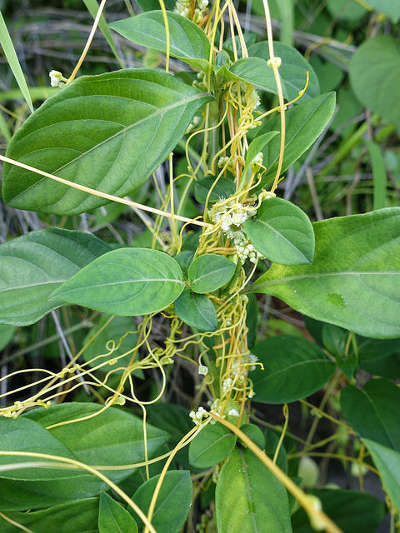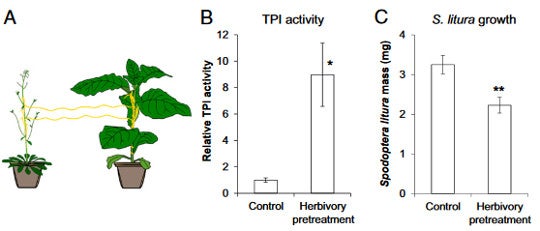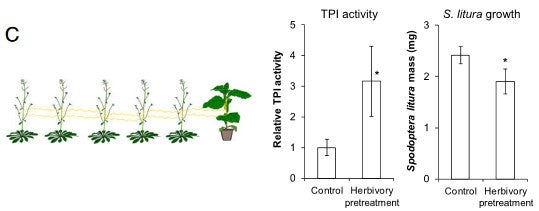This article was published in Scientific American’s former blog network and reflects the views of the author, not necessarily those of Scientific American

The parasite dodder wraps its yellow, stringy tendrils around a victim in Honolulu. Credit: Scott Nelson Flickr(CC-by-2.0)
What the leafless, rootless plant called dodder does to its victims can only be described as creepy: it injects itself into their tissues, permanently fusing their vascular system to its own. But it doesn’t stop there. It continues to seek out new victims, welding each new one into its macabre web while slowly draining them of resources.
On supporting science journalism
If you're enjoying this article, consider supporting our award-winning journalism by subscribing. By purchasing a subscription you are helping to ensure the future of impactful stories about the discoveries and ideas shaping our world today.
All parties involved now effectively have one circulatory system divided into several independently-governed plant principalities. As you can imagine, this can lead to some odd effects.
One such effect is that being tapped by dodder may allow viruses to spread between plants via their parasite in much the same way that plant-sucking insects called aphids and mealybugs transmit disease. Because more than one dodder may be growing in the same area, plants may be fused into multiple dodder networks too, further increasing the chances the parasite will act like a dirty needle.
But joining the dodder collective may not be entirely without benefits either. A team of German and Chinese scientists has conducted experiments that appear to show that the shared vasculature created by dodder permits warning signals from one host to pass to others tapped by the same parasite – even hosts of completely different species. The warnings enable co-hosts to brace themselves for insect attack and reduce their losses once an assault begins.
If real, the phenomenon is another striking example of the sort of botanical super-organism that can emerge when plants are joined by other species into a network. You may remember the other: the network created by symbiotic root fungi between trees, informally called the wood wide web. I have written here before about the astounding ability of these root-dwelling fungi called mycorrhizae to pass signals and food between trees of different species and spoken about it on Radiolab last year. Such systems represent a form of life that rootless animals can never experience, for good or ill.
In herbaceous plants, a group of fungi only distantly related to tree mycorrhizae provide very similar, if not identical, mycorrhizal services. Studies have shown that these fungi – called endomycorrhizae – can transmit warnings that one host in the network is under assault by parasitic fungi or defoliating insects. In response, un-attacked, linked-in hosts pre-emptively activated their defenses and withstood subsequent attack better than plants that had not received such a warning.
But mycorrhizae are a beneficial arrangement between fungi and trees that is generally agreed to be in the interests of all parties. Dodder is a drain on its hosts. It can attack all sorts of plants and lacks roots or leaves. Its spaghetti-like stems sniff out nearby hosts, grasp them, and then penetrate their tissues using peg-like extensions called haustoria. They draw water, food, and other nutrients from these hosts, then branch, grow, and add further victims to their network.
Evolution behaves in funny ways, though. Unexpected effects or features frequently emerge from biological systems established for a different purpose, a concept made famous by Stephen Jay Gould and Richard Lewontin in their paper about the spandrels of San Marco. Until now, no one had tested whether dodder could receive or transmit meaningful signals from a host to another host through its body. A team from the Kunming Institute of Botany led by Christian Hettenhausen and Jianqiang Wu decided to answer those questions.
They began by connecting two plant hosts to each other via dodder, exposing one plant in the pair to hungry Spodoptera litura caterpillars for 48 hours, then watching what happened to all the plants involved. Later, they placed caterpillars on the host plant that had not initially been infested. Because it’s well known that some plants can transmit airborne defensive signals that other plants can smell and respond to, the scientists also tested pairs of plants that had not been connected by dodder.
The results were clear: plants plugged into a dodder network where another member had been attacked increased defensive chemical production and produced skinnier caterpillars, and this was true even when the hosts were from entirely different plant families. When a mustard-like plant called Arabidopsis was connected by dodder to tobacco, tobacco defense chemical production increased eight-fold compared to controls that did not get a warning from a pre-treated Arabidopsis co-host (because the co-host was not infested). The mass of caterpillars on the fore-warned tobacco plants was 32% smaller than on naïve but parasitized control plants.

Arabidopsis (left) connected to tobacco (right) by dodder (A), defense chemical production(TPI activity) in tobacco when warned by Arabidopsis that caterpillars were nearby compared to a control where Arabidopsis was not infested with caterpillars (B), and the weight of caterpillars raised on tobacco when warned by Arabidopsis connected by dodder compared to the same control as in B (C). Credit: Hettenhausen et al. 2017
The magnitude of that protective effect is similar to that seen in tomato plants connected by friendly mycorrhizae, where a 20% decrease in caterpillar mass was observed in plants warned via signals that passed through root fungi.
In the airborne signal control plants not connected by dodder, they did not observe a boost in defense chemicals or a reduction in caterpillar damage as seen in the parasitized plants.
Interestingly, the mechanism used to pass the message also seems to be the same in the parasite as in the symbiotic root fungi. In the experiments with plants connect by mycorrhizae, the scientists demonstrated that when hosts lacked the ability to produce a chemical cascade called the “jasmonate pathway” that plants use to boost their defenses in response to wounding, the message could not be transmitted. Similarly, in dodder-connected plants, if a plant’s gene for synthesizing jasmonic acid was intentionally broken, co-joined hosts did not appear to have received any warning and did not brace themselves for insect attack.
The important and universally understood signals triggered by jasmonic acid and transmitted by dodder or mycorrhizae – whose identity still remains unknown -- must be “well-conserved” to be so readily understood by such distantly related host plants, the scientists reasoned. That is, perhaps, a measure of their evolutionary importance.
Also surprising is the speed with which the warning signals travel through dodder to a second host. In two Arabidopsis plants connected by dodder, the signal traveled from one plant to another within 30 minutes of the first plant’s wounding. It’s likely, the scientists say, that dodder is just a passive conduit as so few of its own genes’ production were altered by the signals’ passage. However, it is also possible that dodder propagates or translates the signal itself somehow.
Perhaps most amazingly, the scientists were also showed the signal can travel a long way without becoming garbled by the game of plant Telephone. The warning chemicals were capable of traveling at least one meter and through at least six different dodder-connected hosts in 90 minutes. And the signal was still meaningful biologically: a tobacco plant six plants down the dodder line from an Arabidopsis plant generating caterpillar warnings elevated its defense chemical production by two-fold (compared to eight-fold when it was next-door) and produced caterpillars 20% lighter than that of controls (compared to 32% when it was adjacent to the signaling plant).

Five Arabidopsis and one tobacco wired up by dodder (A), defense chemical (TPI activity) in the tobacco five doors down from an Arabidopsis being munched on by caterpillars (B), and the mass of caterpillars in tobacco that were either not warned or warned in this same setup. Credit: Hettenhausen et al. 2017
Dodder may not even mind incidental usage of its network. Parasites, in spite of their costs, do have an interest in the health and longevity of their hosts. The authors note that human parasites can sometimes provide health benefits, including increased female fertility (from roundworm infection) or decreased autoimmune disease and allergy (from helminth worms).
Dodder has a vested interest in keeping its hosts alive and healthy (they are its meal ticket, after all), so any low-cost or free services it can provide to them are in the parasite’s interest as well. “[Dodder] provides an information-based means of countering the resource-based fitness costs to their hosts,” as the authors neatly put it.
For a parasitized plant, that may be cold comfort. But misery does love company, and company appears to be the one thing dodder generously provides to its hosts.
References
Hettenhausen, Christian, Juan Li, Huifu Zhuang, Huanhuan Sun, Yuxing Xu, Jinfeng Qi, Jingxiong Zhang et al. "Stem parasitic plant Cuscuta australis (dodder) transfers herbivory-induced signals among plants." Proceedings of the National Academy of Sciences (2017): 201704536.
Song, Yuan Yuan, Mao Ye, Chuanyou Li, Xinhua He, Keyan Zhu-Salzman, Rui Long Wang, Yi Juan Su, Shi Ming Luo, and Ren Sen Zeng. "Hijacking common mycorrhizal networks for herbivore-induced defence signal transfer between tomato plants." Scientific Reports 4 (2014).
Song, Yuan Yuan, Ren Sen Zeng, Jian Feng Xu, Jun Li, Xiang Shen, and Woldemariam Gebrehiwot Yihdego. "Interplant communication of tomato plants through underground common mycorrhizal networks." PloS One 5, no. 10 (2010): e13324.